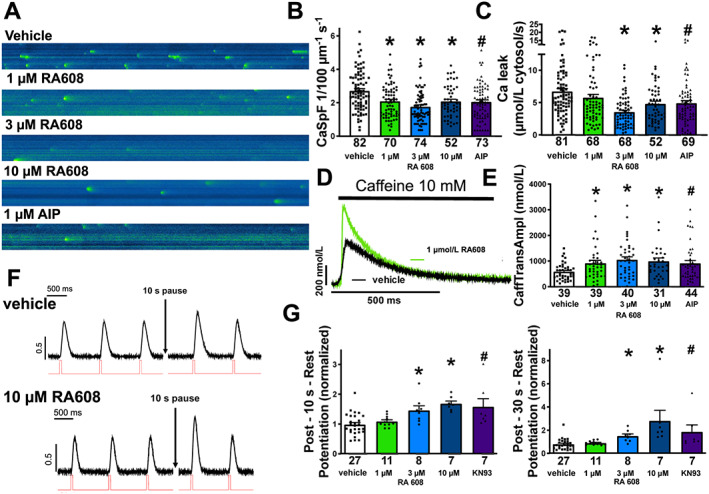Figure 2.

RA608 significantly reduces SR Ca leak in human atrial cardiomyocytes. Original confocal line scans (A) and mean ± SEM for CaSpF (B) and SR Ca leak (C). Compared with vehicle, RA608 significantly reduced CaSpF at 1, 3, and 10 μM and to a similar extent as AIP (patients: vehicle n = 82; 1 μM RA608 = 70, 3 μM RA608 = 74, and 10 μM RA608 = 52; and AIP = 73). This also translated into a significantly reduced SR Ca leak at 3 and 10 μM of RA608 and with AIP (patients: vehicle n = 81; 1 μM RA608 = 68, 3 μM RA608 = 68, and 10 μM RA608 = 52; and AIP = 69). (D) Original traces of caffeine‐induced Ca transient and mean ± SEM data for caffeine‐transient amplitude (E) indicate that RA608 (1, 3, and 10 μM) significantly increased SR Ca content compared with vehicle, comparable to AIP (patients: vehicle n = 39; 1 μM RA608 = 39, 3 μM RA608 = 40, and 10 μM RA608 = 31; and AIP = 44). (F) Original recordings of developed tension of isolated human atrial trabeculae before and following a 10 s pause of electrical stimulation. (G) Mean ± SEM data for post‐rest potentiation. Pre‐incubation with either 3 or 10 μM RA608 significantly increased contractile function after pause (10 s), comparable to AIP (patients: vehicle n = 27; 1 μM RA608 = 11, 3 μM RA608 = 8, and 10 μM RA608 = 7; and AIP = 7). (B, C, E, and G left panel) * P < 0.05 for RA608 vs. vehicle by Dunnett's test after a one‐way repeated ANOVA; # P < 0.05 for AIP or KN93 vs. vehicle using one‐way repeated ANOVA. (G right panel) * P < 0.05 for RA608 vs. vehicle by Dunn's test after a Kruskal–Wallis test (after not meeting normality requirements). # P < 0.05 for KN93 vs. vehicle using Mann–Whitney U test.
